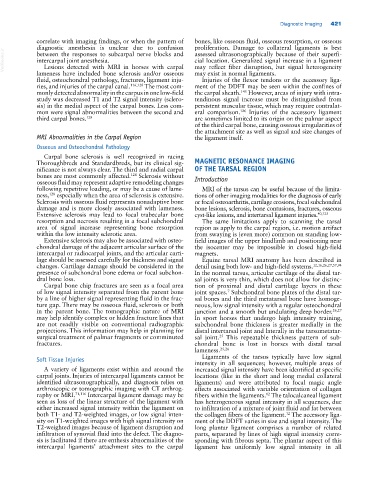Page 455 - Adams and Stashak's Lameness in Horses, 7th Edition
P. 455
Diagnostic Imaging 421
correlate with imaging findings, or when the pattern of bones, like osseous fluid, osseous resorption, or osseous
diagnostic anesthesia is unclear due to confusion proliferation. Damage to collateral ligaments is best
VetBooks.ir intercarpal joint anesthesia. cial location. Generalized signal increase in a ligament
assessed ultrasonographically because of their superfi
between the responses to subcarpal nerve blocks and
may reflect fiber disruption, but signal heterogeneity
Lesions detected with MRI in horses with carpal
lameness have included bone sclerosis and/or osseous may exist in normal ligaments.
fluid, osteochondral pathology, fractures, ligament inju Injuries of the flexor tendons or the accessory liga
ries, and injuries of the carpal canal. 116,128 The most com ment of the DDFT may be seen within the confines of
monly detected abnormality in the carpus in one low‐field the carpal sheath. However, areas of injury with intra
145
study was decreased T1 and T2 signal intensity (sclero tendinous signal increase must be distinguished from
sis) in the medial aspect of the carpal bones. Less com persistent muscular tissue, which may require contralat
126
mon were signal abnormalities between the second and eral comparison. Injuries of the accessory ligament
third carpal bones. 128 are sometimes limited to its origin on the palmar aspect
of the third carpal bone, causing osseous irregularities of
the attachment site as well as signal and size changes of
MRI Abnormalities in the Carpal Region the ligament itself.
Osseous and Osteochondral Pathology
Carpal bone sclerosis is well recognized in racing
Thoroughbreds and Standardbreds, but its clinical sig MAGNETIC RESONANCE IMAGING
nificance is not always clear. The third and radial carpal OF THE TARSAL REGION
bones are most commonly affected. Sclerosis without
128
osseous fluid may represent adaptive remodeling changes Introduction
following repetitive loading, or may be a cause of lame MRI of the tarsus can be useful because of the limita
ness, especially when the area of sclerosis is extensive. tions of other imaging modalities for the diagnosis of early
128
Sclerosis with osseous fluid represents nonadaptive bone or focal osteoarthritis, cartilage erosions, focal subchondral
damage and is more closely associated with lameness. bone lesions, sclerosis, bone contusions, fractures, osseous
Extensive sclerosis may lead to focal trabecular bone cyst‐like lesions, and intertarsal ligament injuries. 40,123
resorption and necrosis resulting in a focal subchondral The same limitations apply to scanning the tarsal
area of signal increase representing bone resorption region as apply to the carpal region, i.e. motion artifact
within the low intensity sclerotic area. from swaying is (even more) common on standing low‐
Extensive sclerosis may also be associated with osteo field images of the upper hindlimb and positioning near
chondral damage of the adjacent articular surface of the the isocenter may be impossible in closed high‐field
intercarpal or radiocarpal joints, and the articular carti magnets.
lage should be assessed carefully for thickness and signal Equine tarsal MRI anatomy has been described in
changes. Cartilage damage should be considered in the detail using both low‐ and high‐field systems. 12,16,26,27,57,94
presence of subchondral bone edema or focal subchon In the normal tarsus, articular cartilage of the distal tar
dral bone loss. sal joints is very thin, which does not allow for distinc
Carpal bone chip fractures are seen as a focal area tion of proximal and distal cartilage layers in these
of low signal intensity separated from the parent bone joint spaces. Subchondral bone plates of the distal tar
7
by a line of higher signal representing fluid in the frac sal bones and the third metatarsal bone have homoge
ture gap. There may be osseous fluid, sclerosis or both neous, low signal intensity with a regular osteochondral
in the parent bone. The tomographic nature of MRI junction and a smooth but undulating deep border. 26,27
may help identify complex or hidden fracture lines that In sport horses that undergo high intensity training,
are not readily visible on conventional radiographic subchondral bone thickness is greater medially in the
projections. This information may help in planning for distal intertarsal joint and laterally in the tarsometatar
surgical treatment of palmar fragments or comminuted sal joint. This repeatable thickness pattern of sub
25
fractures. chondral bone is lost in horses with distal tarsal
lameness. 25,26
Ligaments of the tarsus typically have low signal
Soft Tissue Injuries
intensity in all sequences; however, multiple areas of
A variety of ligaments exist within and around the increased signal intensity have been identified at specific
carpal joints. Injuries of intercarpal ligaments cannot be locations (like in the short and long medial collateral
identified ultrasonographically, and diagnosis relies on ligaments) and were attributed to focal magic angle
arthroscopic or tomographic imaging with CT arthrog effects associated with variable orientation of collagen
raphy or MRI. 71,116 Intercarpal ligament damage may be fibers within the ligaments. The talocalcaneal ligament
12
seen as loss of the linear structure of the ligament with has heterogeneous signal intensity in all sequences, due
either increased signal intensity within the ligament on to infiltration of a mixture of joint fluid and fat between
both T1‐ and T2‐weighted images, or low signal inten the collagen fibers of the ligament. The accessory liga
12
sity on T1‐weighted images with high signal intensity on ment of the DDFT varies in size and signal intensity. The
T2‐weighted images because of ligament disruption and long plantar ligament comprises a number of related
infiltration of synovial fluid into the defect. The diagno parts, separated by lines of high signal intensity corre
sis is facilitated if there are enthesis abnormalities of the sponding with fibrous septa. The plantar aspect of this
intercarpal ligaments’ attachment sites to the carpal ligament has uniformly low signal intensity in all

